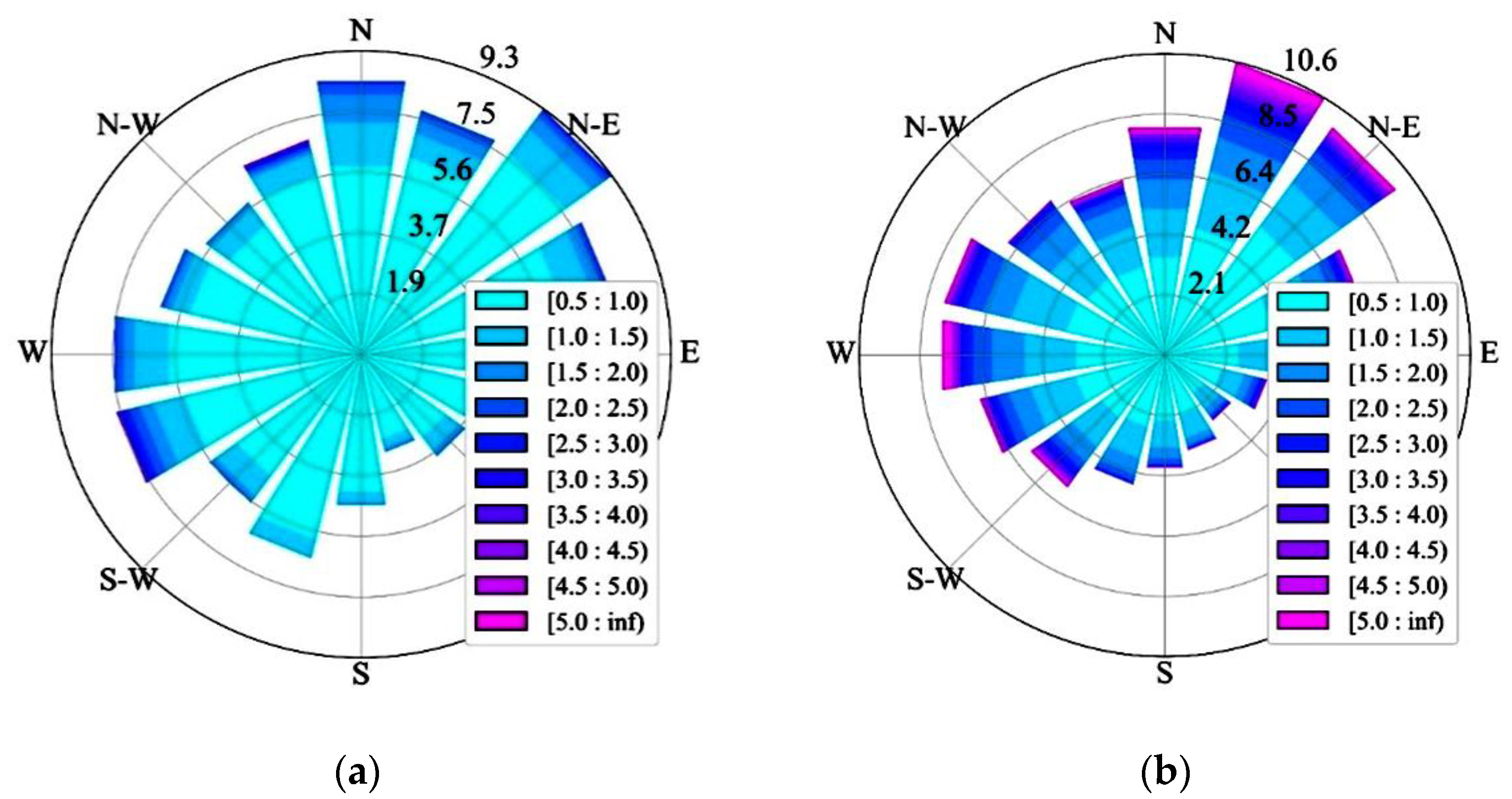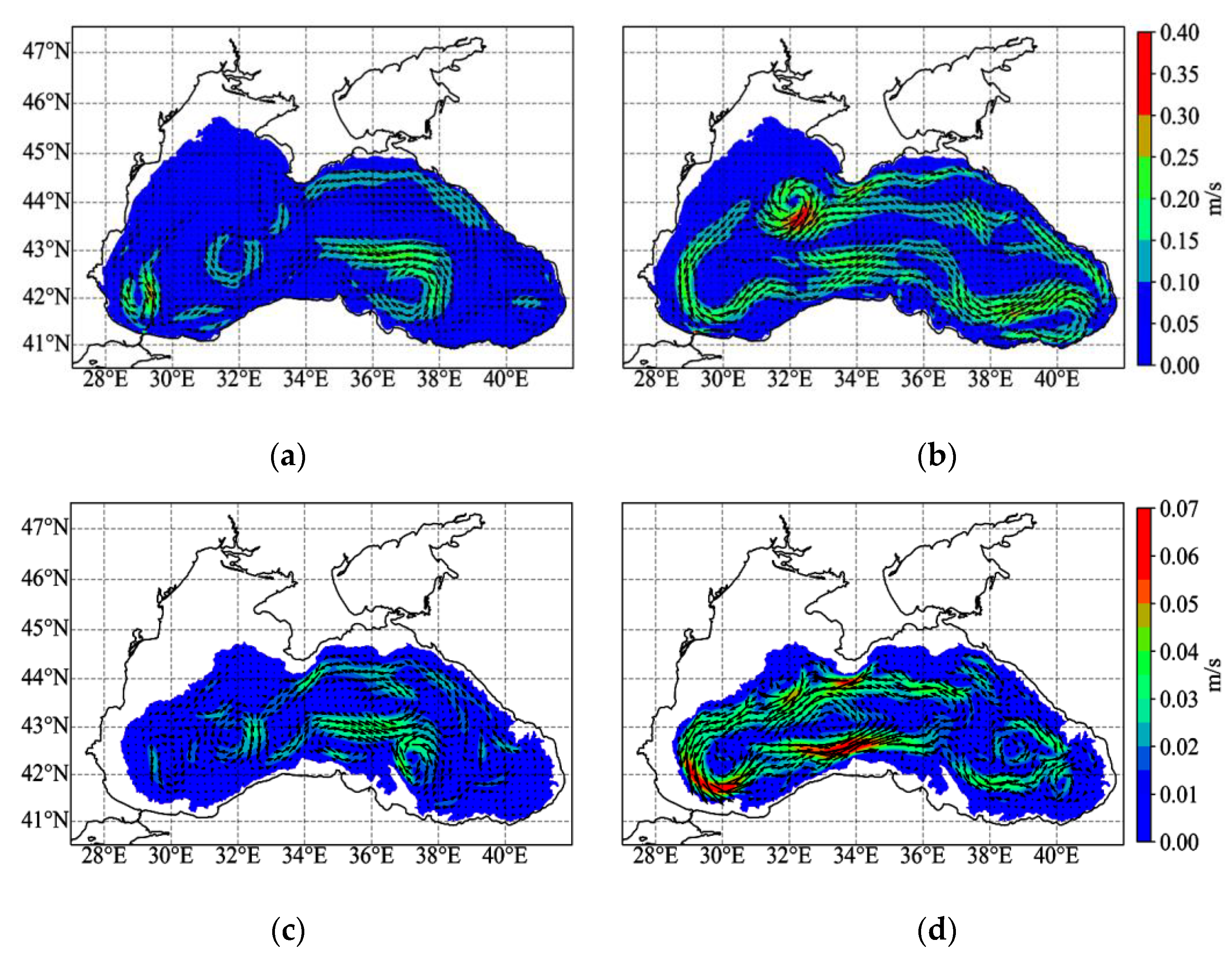Numerical Estimation of the Black Sea Circulation near the Continental Slope Using SKIRON and ERA5 Atmospheric Forcing †
Abstract
:1. Introduction
2. Materials and Methods
3. Results
4. Conclusions
Author Contributions
Funding
Institutional Review Board Statement
Informed Consent Statement
Data Availability Statement
Acknowledgments
Conflicts of Interest
References
- Capet, A.; Barth, A.; Beckers, J.-M.; Marilaure, G. Interannual variability of Black Sea’s hydrodynamics and connection to atmospheric patterns. Deep Sea Res. II 2012, 77–80, 128–142. [Google Scholar] [CrossRef] [Green Version]
- Kubryakov, A.A.; Stanichny, S.V.; Zatsepin, A.G.; Kremenetskiy, V.V. Long-term variations of the Black Sea dynamics and their impact on the marine ecosystem. J. Mar. Syst. 2016, 163, 80–94. [Google Scholar] [CrossRef]
- Ivanov, V.A.; Belokopytov, V.N. Oceanography of the Black Sea; ECOSY-Gidrofizika: Sevastopol, Ukraine, 2013; pp. 65–71. [Google Scholar]
- Zatsepin, A.G.; Korzh, A.O.; Kremenetskii, V.V.; Ostrovskii, A.G.; Poyarkov, S.G.; Solov’ev, D.M. Studies of the hydrophysical processes over the shelf and upper part of the continental slope of the Black Sea with the use of traditional and new observation techniques. Oceanology 2008, 48, 466–475. [Google Scholar] [CrossRef]
- Korotenko, K.; Osadchiev, A.; Melnikov, V. Mesoscale Eddies in the Black Sea and Their Impact on River Plumes: Numerical Modeling and Satellite Observations. Remote Sens. 2022, 14, 4149. [Google Scholar] [CrossRef]
- Demyshev, S.G.; Dymova, O.A.; Markova, N.V.; Korshenko, E.A.; Senderov, M.V.; Turko, N.A.; Ushakov, K.V. Undercurrents in the northeastern Black Sea detected on the basis of multi-model experiments and observations. J. Mar. Sci. Eng. 2021, 9, 933. [Google Scholar] [CrossRef]
- Staneva, J.V.; Dietrich, D.E.; Stanev, E.V.; Bowman, M.J. Rim current and coastal eddy mechanisms in an eddy-resolving Black Sea general circulation model. J. Mar. Syst. 2001, 31, 137–157. [Google Scholar] [CrossRef] [Green Version]
- Demyshev, S.G.; Dymova, O.A. Analysis of the annual mean energy cycle of the Black Sea circulation for the climatic, basin-scale and eddy regimes. Ocean Dyn. 2022, 72, 259–278. [Google Scholar] [CrossRef]
- European Marine Observation and Data Network (EMODnet). EMODnet Digital Bathymetry (DTM 2020)-Tile D3. Available online: https://emodnet.ec.europa.eu/geonetwork/srv/eng/catalog.search#/metadata/19f800a9-f0fd-4055-b4cd-90ed156dc7fc/ (accessed on 12 March 2023).
- Lima, L.; Masina, S.; Ciliberti, S.A.; Peneva, E.L.; Cretí, S.; Stefanizzi, L.; Lecci, R.; Palermo, F.; Coppini, G.; Pinardi, N.; et al. Black Sea Physical Reanalysis (CMEMS BS-Currents) (Version 1) Data Set; Copernicus Monitoring Environment Marine Service (CMEMS), 2020. [Google Scholar] [CrossRef]
- Kallos, G.; Nickovic, S.; Papadopoulos, A.; Jovic, D.; Kakaliagou, O.; Misirlis, N.; Boukas, L.; Mimikou, N.; Sakellaridis, G. The regional weather forecasting system SKIRON: An overview. In Proceedings of the International Symposium on Regional Weather Prediction on Parallel Computer Environments, Athens, Greece, 15–17 October 1997; pp. 109–122. [Google Scholar]
- Hersbach, H.; Bell, B.; Berrisford, P.; Biavati, G.; Horányi, A.; Muñoz Sabater, J. ERA5 Hourly Data on Single Levels from 1959 to Present; Copernicus Climate Change Service (C3S), Climate Data Store (CDS), 2018. [Google Scholar] [CrossRef]
- Coriolis. Available online: https://dataselection.coriolis.eu.org/ (accessed on 12 March 2023).
- Artamonov, Y.V.; Skripaleva, E.A.; Alekseev, D.V.; Fedirko, A.V.; Shutov, S.A.; Kolmak, R.V.; Shapovalov, R.O.; Shcherbachenko, S.V. Hydrological Research in the Northern Part of the Black Sea in 2016 (87th, 89th and 91st Cruises of R/V Professor Vodyanitsky). Phys. Oceanogr. 2018, 25, 229–234. [Google Scholar] [CrossRef] [Green Version]
- Francis, P.A.; Jithin, A.K.; Chatterjee, A.; Mukherjee, A.; Shankar, D.; Vinayachandran, P.N.; Ramakrishna, S.S.V.S. Structure and dynamics of undercurrents in the western boundary current of the Bay of Bengal. Ocean Dyn. 2020, 70, 387–404. [Google Scholar] [CrossRef]




| Depth, m | Temperature, °C | Salinity, psu | ||
|---|---|---|---|---|
| SKIRON | ERA5 | SKIRON | ERA5 | |
| 0–5 | 1.175 | 0.625 | 0.224 | 0.258 |
| 5–30 | 2.390 | 1.706 | 0.188 | 0.212 |
| 30–100 | 0.623 | 0.489 | 0.454 | 0.384 |
| 100–300 | 0.199 | 0.154 | 0.423 | 0.312 |
| 300–800 | 0.036 | 0.055 | 0.072 | 0.084 |
| 800–1500 | 0.030 | 0.027 | 0.055 | 0.075 |
Disclaimer/Publisher’s Note: The statements, opinions and data contained in all publications are solely those of the individual author(s) and contributor(s) and not of MDPI and/or the editor(s). MDPI and/or the editor(s) disclaim responsibility for any injury to people or property resulting from any ideas, methods, instructions or products referred to in the content. |
© 2023 by the authors. Licensee MDPI, Basel, Switzerland. This article is an open access article distributed under the terms and conditions of the Creative Commons Attribution (CC BY) license (https://creativecommons.org/licenses/by/4.0/).
Share and Cite
Dymova, O.; Markova, N. Numerical Estimation of the Black Sea Circulation near the Continental Slope Using SKIRON and ERA5 Atmospheric Forcing. Environ. Sci. Proc. 2023, 25, 61. https://doi.org/10.3390/ECWS-7-14305
Dymova O, Markova N. Numerical Estimation of the Black Sea Circulation near the Continental Slope Using SKIRON and ERA5 Atmospheric Forcing. Environmental Sciences Proceedings. 2023; 25(1):61. https://doi.org/10.3390/ECWS-7-14305
Chicago/Turabian StyleDymova, Olga, and Natalia Markova. 2023. "Numerical Estimation of the Black Sea Circulation near the Continental Slope Using SKIRON and ERA5 Atmospheric Forcing" Environmental Sciences Proceedings 25, no. 1: 61. https://doi.org/10.3390/ECWS-7-14305
APA StyleDymova, O., & Markova, N. (2023). Numerical Estimation of the Black Sea Circulation near the Continental Slope Using SKIRON and ERA5 Atmospheric Forcing. Environmental Sciences Proceedings, 25(1), 61. https://doi.org/10.3390/ECWS-7-14305






